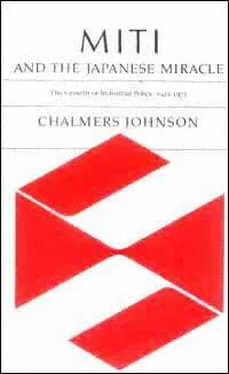Chalmers Johnson - MITI and the Japanese miracle
Здесь есть возможность читать онлайн «Chalmers Johnson - MITI and the Japanese miracle» весь текст электронной книги совершенно бесплатно (целиком полную версию без сокращений). В некоторых случаях можно слушать аудио, скачать через торрент в формате fb2 и присутствует краткое содержание. Год выпуска: 2007, Издательство: Stanford University Press, Жанр: Старинная литература, на английском языке. Описание произведения, (предисловие) а так же отзывы посетителей доступны на портале библиотеки ЛибКат.
- Название:MITI and the Japanese miracle
- Автор:
- Издательство:Stanford University Press
- Жанр:
- Год:2007
- ISBN:нет данных
- Рейтинг книги:3 / 5. Голосов: 1
-
Избранное:Добавить в избранное
- Отзывы:
-
Ваша оценка:
- 60
- 1
- 2
- 3
- 4
- 5
MITI and the Japanese miracle: краткое содержание, описание и аннотация
Предлагаем к чтению аннотацию, описание, краткое содержание или предисловие (зависит от того, что написал сам автор книги «MITI and the Japanese miracle»). Если вы не нашли необходимую информацию о книге — напишите в комментариях, мы постараемся отыскать её.
MITI and the Japanese miracle — читать онлайн бесплатно полную книгу (весь текст) целиком
Ниже представлен текст книги, разбитый по страницам. Система сохранения места последней прочитанной страницы, позволяет с удобством читать онлайн бесплатно книгу «MITI and the Japanese miracle», без необходимости каждый раз заново искать на чём Вы остановились. Поставьте закладку, и сможете в любой момент перейти на страницу, на которой закончили чтение.
Интервал:
Закладка:
46
Yoshida pushed the loan agreements through anyway; in the autumn of 1953 the World Bank made its first loan of $40.2 million to the Kansai, Chubu, and Kyushu Electric Power companies to build thermal generating plants. In later years the steel companies also borrowed from the World Bank. MITI was delighted with these loans, but it also saw in the political controversy surrounding them a potent reason to continue with its own approach to rapid economic development.
Once the occupation had ended, the Yoshida government ordered a general review of the executive branch and of all laws and ordinances inherited from the SCAP era. Among other things Yoshida himself wanted to abolish the Economic Stabilization Board as a symbol of the controlled economy, but MITI, which sent by far the largest number of officials to it, liked it. In order to save it, Hirai Tomisaburo* of MITI bypassed Yoshida to obtain the Liberal Party's agreement to transform the ESB into a smaller (only 399 officials) organ for economic analysis and forecasting.
47
Thus, on August 1, 1952, the powerful ESB ("whose name alone would stop a child's crying") became the Economic Deliberation Agency (EDA; Keizai Shingi Cho*), a "think tank" with no operational duties at all. On July 20, 1955, after Yoshida had left the scene, its name was changed to Economic Planning Agency (EPA; Keizai Kikaku Cho).
MITI continued to regard the EDA/EPA as its own "branch store"it appointed the agency's vice-minister, the chief of its Coordination Bureau, and numerous other key posts. Moreover, in 1952 the substantive powers of the old ESB were all transferred to MITI. The International Trade Bureau (ITB) took over preparation and administration of the foreign exchange budget, and the Enterprises Bureau began to screen all foreign investment proposals. These developments transformed the ITB; its offices on the third floor of the old MITI office building became known as the "Toranomon Ginza" because of the
Page 221
hundreds of importers gathered there daily to seek licenses. Journalistic observers of MITI have also concluded that this was the ministry's most corrupt period. Officials of the ITB received numerous presents and invitations to mahjong sessions (at which they never seemed to lose money); and some trading companies employed attractive female negotiators to deal with the ITB.
48
It has been alleged that officials even sold copies of the "secret" foreign exchange budget for large sums, it being of great value to importers in calculating how much of each commodity would be approved.
49
These conditions were the natural concomitants of tightly controlled trade, but they did not do anything for the ITB's reputation.
MITI used the opportunity of Yoshida's postoccupation review to reorganize itself totally. The Secretariat rewrote the MITI Establishment Law, and the new law, number 275, was passed on July 31, 1952. It eliminated the old prefix tsusho* (international trade) from the names of the industrial bureaus; combined the ITB and the Trade Promotion Bureau into one large unit; and abolished SCAP's Public Utilities Commission, which had been attached to the prime minister's office. In its place there was set up in MITI a Public Utilities Bureau, the direct successor of the old Electric Power Bureau that the Ministry of Munitions had acquired when it was established in 1943. The sections of the Enterprises Bureau were also expanded to accommodate the planning and control functions of the defunct ESB. MITI thus took on the form that it would retain throughout the high-speed growth period and down to the reform of 1973 (see Appendix B).
During the crucial years 195253 MITI undertook some other initiatives that set it on a collision course with a famous SCAP-created institution, the Fair Trade Commission (FTC; Kosei* Torihiki Iinkai), guardian and administrator of the so-called economic constitution, the Antimonopoly Law. The Antimonopoly Law, which is formally called the Law Relating to the Prohibition of Private Monopoly and to Methods of Preserving Fair Trade (Shiteki Dokusen no Kinshi oyobi Kosei Torihiki no Kakuho ni kan suru Horitsu*, number 54 of April 14, 1947) had a checkered career even before the occupation ended. SCAP defended it on the grounds that "with the exception of the Unfair Competition Law of 1934, which primarily dealt with imitating and palming off one's goods as those of another, Japanese legislation did not embody any rules against unfair trade practices generally and did not recognize any concept of free, competitive enterprise as being in the public interest"; but SCAP also acknowledged that "many civil servants in various departments of the Government exhibited a strong lack of sympathy or support for the antitrust program."
50
Page 222
As originally drafted, the law prohibited collusive activities among entrepreneurs to set prices, restrict the volume of production or sales, divide markets or customers among themselves, limit the construction or expansion of facilities, or refuse to share new technologies or methods of production. Article 9 of the lawas famous in its own right as article 9 of the constitution, which outlaws the use of armed forcebanned holding companies, and this article has survived intact to the present day. Holding companies in fact do not exist in the postwar Japanese economy; the zaibatsu were rebuilt on another basis entirelythat of the banking keiretsu discussed above. The law also created the Fair Trade Commission, composed of seven members who are appointed by the prime minister with the consent of the House of Representatives for five-year terms.
Modifications to the law began almost as soon as it had been passed. SCAP discovered that firms could evade the law by creating "trade associations" as noncommercial unions or foundations (
kumiai, shadan
, or
zaidan
) under the terms of the Civil Code. Because of this, SCAP ordered the Japanese government to enact the Trade Associations Law (number 191 of July 29, 1948), which required any association of two or more businessmen to register with the FTC within thirty days of its establishment. MITI had this law abolished in 1953.
Another problem was that ever since Yoshino's industrial unions law of 1925, medium and smaller enterprises had depended on their cartels to remain in business without resorting to dumping. SCAP agreed that they needed some special help, but rather than authorize their cartels as exceptions to the Antimonopoly Law (AML), it sponsored the creation on August 1, 1948, of the Medium and Smaller Enterprises Agency (MSEA) as an external agency first of MCI and subsequently of MITI. This organ was supposed to gather, analyze, and freely distribute information on the procurement of materials, marketing possibilities, business methods, and so forthin effect, to act as a cartel headquarters for the small business sector. The first director of the MSEA, Ninagawa Torazo * (former dean of economics at Kyoto University), fought vigorously with both SCAP and the Yoshida government to get more powers and a secure budget for his unit; he particularly wanted governmental financing for small businesses.
After SCAP pressured the government to do as Ninagawa asked (law number 108 of April 24, 1950, amending the MITI Establishment Law), he resigned and was elected mayor of Kyoto, a city with many medium and smaller enterprises. Backed by the socialists and communists, Ninagawa served from 1950 to 1978 as mayor of Kyoto,
Page 223
where he became a persistent thorn in the side of the national conservative establishment. MITI was never very enthusiastic about the MSEA, but it had no choice other than to support it because of the political clout the small-business sector wields. Moreover, some MITI officials discovered that the directorship of the MSEA was an excellent place from which to build support for their own postretirement political careers. MITI's attitude toward the MSEA has consequently remained ambivalent over the years; it is today an integral, if non-mainstream, unit of the ministry.
Читать дальшеИнтервал:
Закладка:
Похожие книги на «MITI and the Japanese miracle»
Представляем Вашему вниманию похожие книги на «MITI and the Japanese miracle» списком для выбора. Мы отобрали схожую по названию и смыслу литературу в надежде предоставить читателям больше вариантов отыскать новые, интересные, ещё непрочитанные произведения.
Обсуждение, отзывы о книге «MITI and the Japanese miracle» и просто собственные мнения читателей. Оставьте ваши комментарии, напишите, что Вы думаете о произведении, его смысле или главных героях. Укажите что конкретно понравилось, а что нет, и почему Вы так считаете.












